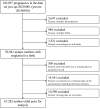Prevalence of infectious diseases in preterm infants: a 2-year follow-up from the Japan Environment and Children's Study
- PMID: 36577762
- PMCID: PMC9797578
- DOI: 10.1038/s41598-022-26748-0
Prevalence of infectious diseases in preterm infants: a 2-year follow-up from the Japan Environment and Children's Study
Abstract
Evidence regarding the long-term risk of infections in preterm infants is lacking. In this study, we examined whether preterm infants developed various common childhood infections more frequently than full-term infants by the age of 2 years by analyzing data from a questionnaire completed by 67,282 mother-toddler pairs in a nationwide birth cohort study. Of the target population, 2885 (4.3%) were born prematurely. After covariate adjustment for maternal and children factors, lower respiratory tract infections appeared more frequent in preterm than in full-term infants at both 1 and 2 years (adjusted odds ratio [aOR] 1.21, 95% confidence interval [CI] 1.05-1.41, and aOR 1.27, 95% CI 1.11-1.46, respectively). However, there was no significant difference in the frequencies of lower respiratory tract infection between preterm and full-term infants after Palivizumab administration. The risk of other common infections, such as in the upper respiratory tract infection, otitis media, urinary tract infection, gastroenteritis, herpangina, hand-foot-and-mouth disease, chickenpox, influenza virus, and adenovirus infections, was not higher in preterm than in full-term infants after covariates adjustment for maternal and children factors. These findings suggest Palivizumab prophylaxis could reduce the frequencies of lower respiratory tract infection in preterm to the same level as in full-term infants.
© 2022. The Author(s).
Conflict of interest statement
The authors declare no competing interests.
Figures
Similar articles
-
Efficacy of palivizumab prophylaxis on the frequency of RSV-associated lower respiratory tract infections in preterm infants: determination of the ideal target population for prophylaxis.Eur J Clin Microbiol Infect Dis. 2017 Sep;36(9):1629-1634. doi: 10.1007/s10096-017-2976-x. Epub 2017 Apr 8. Eur J Clin Microbiol Infect Dis. 2017. PMID: 28391538
-
Infant respiratory syncytial virus prophylaxis and nasopharyngeal microbiota until 6 years of life: a subanalysis of the MAKI randomised controlled trial.Lancet Respir Med. 2020 Oct;8(10):1022-1031. doi: 10.1016/S2213-2600(19)30470-9. Epub 2020 Mar 20. Lancet Respir Med. 2020. PMID: 32203712 Clinical Trial.
-
Cost-utility analysis of Palivizumab for Respiratory Syncytial Virus infection prophylaxis in preterm infants: update based on the clinical evidence in Spain.BMC Infect Dis. 2017 Oct 17;17(1):687. doi: 10.1186/s12879-017-2803-0. BMC Infect Dis. 2017. PMID: 29041909 Free PMC article.
-
Clinical relevance of prevention of respiratory syncytial virus lower respiratory tract infection in preterm infants born between 33 and 35 weeks gestational age.Eur J Clin Microbiol Infect Dis. 2008 Oct;27(10):891-9. doi: 10.1007/s10096-008-0520-8. Epub 2008 Jul 16. Eur J Clin Microbiol Infect Dis. 2008. PMID: 18629558 Review.
-
Expert consensus on palivizumab use for respiratory syncytial virus in developed countries.Paediatr Respir Rev. 2020 Feb;33:35-44. doi: 10.1016/j.prrv.2018.12.001. Epub 2018 Dec 18. Paediatr Respir Rev. 2020. PMID: 31060948 Review.
Cited by
-
Impact of maternal whole-cell or acellular pertussis primary immunization on neonatal immune response.Front Immunol. 2023 Jun 26;14:1192119. doi: 10.3389/fimmu.2023.1192119. eCollection 2023. Front Immunol. 2023. PMID: 37435078 Free PMC article.
References
-
- Vital statistics, Ministry of Health, Labour and Welfare, Japan. https://www.mhlw.go.jp/toukei/list/81-1a.html (2022)
Publication types
MeSH terms
Substances
LinkOut - more resources
Full Text Sources
Medical


